Heterozygosity for Pten promotes tumorigenesis in a mouse model of medulloblastoma
- PMID: 20520772
- PMCID: PMC2877103
- DOI: 10.1371/journal.pone.0010849
Heterozygosity for Pten promotes tumorigenesis in a mouse model of medulloblastoma
Abstract
Background: Recent publications have described an important role for cross talk between PI-3 kinase and sonic hedgehog signaling pathways in the pathogenesis of medulloblastoma.
Methodology/principal findings: We crossed mice with constitutive activation of Smoothened, SmoA1, with Pten deficient mice. Both constitutive and conditional Pten deficiency doubled the incidence of mice with symptoms of medulloblastoma and resulted in decreased survival. Analysis revealed a clear separation of gene signatures, with up-regulation of genes in the PI-3 kinase signaling pathway, including downstream activation of angiogenesis in SmoA1+/-; Pten +/- medulloblastomas. Western blotting and immunohistochemistry confirmed reduced or absent Pten, Akt activation, and increased angiogenesis in Pten deficient tumors. Down-regulated genes included genes in the sonic hedgehog pathway and tumor suppressor genes. SmoA1+/-; Pten +/+ medulloblastomas appeared classic in histology with increased proliferation and diffuse staining for apoptosis. In contrast, Pten deficient tumors exhibited extensive nodularity with neuronal differentiation separated by focal areas of intense staining for proliferation and virtually absent apoptosis. Examination of human medulloblastomas revealed low to absent PTEN expression in over half of the tumors. Kaplan-Meier analysis confirmed worse overall survival in patients whose tumor exhibited low to absent PTEN expression.
Conclusions/significance: This suggests that PTEN expression is a marker of favorable prognosis and mouse models with activation of PI-3 kinase pathways may be important tools for preclinical evaluation of promising agents for the treatment of medulloblastoma.
Conflict of interest statement
Figures
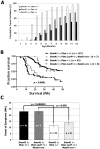
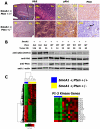
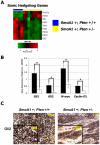
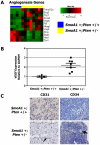
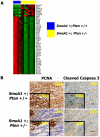

Similar articles
-
Phosphatidylinositol 3'-kinase/AKT signaling is activated in medulloblastoma cell proliferation and is associated with reduced expression of PTEN.Clin Cancer Res. 2006 May 15;12(10):3019-27. doi: 10.1158/1078-0432.CCR-05-2187. Clin Cancer Res. 2006. PMID: 16707597
-
PI-3K Inhibitors Preferentially Target CD15+ Cancer Stem Cell Population in SHH Driven Medulloblastoma.PLoS One. 2016 Mar 3;11(3):e0150836. doi: 10.1371/journal.pone.0150836. eCollection 2016. PLoS One. 2016. PMID: 26938241 Free PMC article.
-
The SmoA1 mouse model reveals that notch signaling is critical for the growth and survival of sonic hedgehog-induced medulloblastomas.Cancer Res. 2004 Nov 1;64(21):7794-800. doi: 10.1158/0008-5472.CAN-04-1813. Cancer Res. 2004. PMID: 15520185
-
Molecular neuro-oncology and development of targeted therapeutic strategies for brain tumors. Part 2: PI3K/Akt/PTEN, mTOR, SHH/PTCH and angiogenesis.Expert Rev Anticancer Ther. 2004 Feb;4(1):105-28. doi: 10.1586/14737140.4.1.105. Expert Rev Anticancer Ther. 2004. PMID: 14748662 Review.
-
PI3K/PTEN signaling in angiogenesis and tumorigenesis.Adv Cancer Res. 2009;102:19-65. doi: 10.1016/S0065-230X(09)02002-8. Adv Cancer Res. 2009. PMID: 19595306 Free PMC article. Review.
Cited by
-
Novel mutations target distinct subgroups of medulloblastoma.Nature. 2012 Aug 2;488(7409):43-8. doi: 10.1038/nature11213. Nature. 2012. PMID: 22722829 Free PMC article.
-
Targeting Angiogenic Factors for the Treatment of Medulloblastoma.Curr Treat Options Oncol. 2022 Jun;23(6):864-886. doi: 10.1007/s11864-022-00981-1. Epub 2022 Apr 12. Curr Treat Options Oncol. 2022. PMID: 35412196 Review.
-
Reproducibility of academic preclinical translational research: lessons from the development of Hedgehog pathway inhibitors to treat cancer.Open Biol. 2018 Aug;8(8):180098. doi: 10.1098/rsob.180098. Open Biol. 2018. PMID: 30068568 Free PMC article. Review.
-
BCCIP suppresses tumor initiation but is required for tumor progression.Cancer Res. 2013 Dec 1;73(23):7122-33. doi: 10.1158/0008-5472.CAN-13-1766. Epub 2013 Oct 21. Cancer Res. 2013. PMID: 24145349 Free PMC article.
-
Decoding the Roles of Astrocytes and Hedgehog Signaling in Medulloblastoma.Curr Oncol. 2021 Aug 11;28(4):3058-3070. doi: 10.3390/curroncol28040267. Curr Oncol. 2021. PMID: 34436033 Free PMC article. Review.
References
-
- Rood BR, Macdonald TJ, Packer RJ. Current treatment of medulloblastoma: recent advances and future challenges. Semin Oncol. 2004;31:666–675. - PubMed
-
- Giangaspero F BS, Giordana MT, Kleihues P, Trojanowski JQ. Medulloblastoma; In: Kleihues PCW, editor. Lyon, France: International Agency for Research of Cancer; 2000. pp. 96–103.
-
- Rutkowski S, Bode U, Deinlein F, Ottensmeier H, Warmuth-Metz M, et al. Treatment of early childhood medulloblastoma by postoperative chemotherapy alone. N Engl J Med. 2005;352:978–986. - PubMed
-
- Garre ML, Cama A, Bagnasco F, Morana G, Giangaspero F, et al. Medulloblastoma variants: age-dependent occurrence and relation to Gorlin syndrome–a new clinical perspective. Clin Cancer Res. 2009;15:2463–2471. - PubMed
-
- Packer RJ, Rood BR, MacDonald TJ. Medulloblastoma: present concepts of stratification into risk groups. Pediatr Neurosurg. 2003;39:60–67. - PubMed
Publication types
MeSH terms
Substances
Grants and funding
LinkOut - more resources
Full Text Sources
Molecular Biology Databases
Research Materials
Miscellaneous

